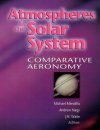About this book
Atmospheres are crucial components of our universe. They are the only observable regions of stars and giant planets, both within and beyond our solar system. Some terrestrial-size bodies (Venus, Earth, Mars, Titan and Triton) have permanent atmospheres while others (e.g., Mercury, Moon, Io, and Europa) have tenuous gaseous envelopes that change daily. Comets are tiny bodies by planetary yardsticks, but their atmospheres can be the largest visible objects in the night sky. Atmospheric science strives to understand how such a diverse set of atmospheres form, evolve, and disappear.
Contents
Preface
Michael Mendillo, Andrew Nagy, and J. H. Waite ix
Introduction
Michael Mendillo, Andrew Nagy, and J. H. Waite 1
I. Overviews
1 Aeronomic Systems on Planets, Moons, and Comets
Darrell E. Strobel 7
2 Solar System Upper Atmospheres: Photochemistry, Energetics, and Dynamics
G. Randall Gladstone, Roger V. Yelle, and J. Majeed 23
3 Solar System Ionospheres
Andrew F. Nagy and Thomas E. Cravens 39
4 Auroral Processes in the Solar System
Marina Galand and Supriya Chakrabarti 55
5 Airglow Processes in Planetary Atmospheres
T. G. Slanger and B. C. Wolven 77
II. Interactions Between Planetary and Small Body Atmospheres with the Surrounding Plasma Medium
1 Magnetosphere-Ionosphere Coupling at Earth, Jupiter, and Beyond
B. H. Mauk, B. J. Anderson, and R. M. Thome 97
2 Comparison of Auroral Processes: Earth and Jupiter
J. H. Waite and Dirk Lummerzheim 115
3 Numerical Techniques Associated with Simulations of the Solar Wind Interactions with Non-Magnetized Bodies
Stephen H. Brecht 141
4 Plasma Flow Past Cometary and Planetary Satellite Atmospheres
Michael R. Combi, Tamas I. Gombosi, and Konstantin Kabin 151
III. Chemistry, Energetics and Dynamics
1 Wave Coupling in Terrestrial Planetary Atmospheres
Jeffrey M. Forbes 171
2 Exospheres and Planetary Escape
Donald M. Hunten 191
3 Surface Boundary Layer Atmospheres
R. £ Johnson 203
4 Solar Ultraviolet Variability Over Time Periods of Aeronomic Interest
Thomas N. Woods and Gary J. Rottman 221
5 Meteoric Material—An Important Component of Planetary Atmospheres
Joseph M. Grebowsky, Julianne I. Moses, and W. Dean Pesnell 235
6 Current Laboratory Experiments for Planetary Aeronomy
David L. Huestis 245
IV. Models of Aeronomic Systems
1 Simulations of the Upper Atmospheres of the Terrestrial Planets
Stephen W. Bougher, Raymond G. Roble, and Timothy Fuller-Rowel I. 261
2 Thermospheric General Circulation Models for the Giant Planets: The Jupiter Case
GH. Millward, S. Miller, A.D. Aylward, I. C. F Muller-Wodarg, and N. Achilleos 289
3 Ionospheric Models for Earth
R. W Schunk 299
4 The Application of General Circulation Models to the Atmospheres of Terrestrial-Type Moons of the Giant Planets
I. C. F Muller-Wodarg 307
5 The Extreme Ultraviolet Airglow of N2 Atmospheres
Michael H. Stevens 319
V. Observational Applications
1 The Application of Terrestrial Aeronomy Groundbased Instruments to Planetary Studies
Michael Mendillo, Fred Roesler, Chester Gardner, and Michael Sulzer 329
2 Ultraviolet Remote Sensing Techniques for Planetary Aeronomy
John T. Clarke and Larry Paxton 339
3 Mass Spectrometry for Planetary Science
David T. Young 353
VI. Atmospheres of Other Worlds
1 A Possible Aeronomy of Extrasolar Terrestrial Planets
W. A. Traub and K. W Jucks 369
2 Can Conditions for Life be Inferred From Optical Emissions of Extra-Solar-System Planets?
Harald U. Frey and Dirk Lummerzheim 381
Customer Reviews






































